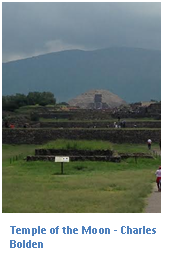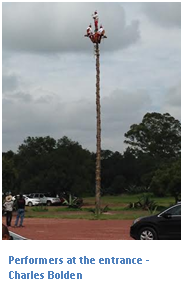Blog #7 – July 6, 2014
by Erin Shew, Charles Bolden, Aaron Groth, Dan Roper, Marco Pagani
 Day 7 of ICRPS 2014 brought the option of a day of rest and relaxation, but who wants to stay in Toluca when there are pyramids to explore and a fascinating culture to learn more about? A few people who had already been to Teotihuacan chose to stay in Toluca and explore our Mexican home away from home a bit more, but the majority of our group headed off to Teotihuacan, complete with police escort!
Day 7 of ICRPS 2014 brought the option of a day of rest and relaxation, but who wants to stay in Toluca when there are pyramids to explore and a fascinating culture to learn more about? A few people who had already been to Teotihuacan chose to stay in Toluca and explore our Mexican home away from home a bit more, but the majority of our group headed off to Teotihuacan, complete with police escort!
We were greeted by a trio of performers sitting on top of a high platform, dressed in  traditional dress and playing flutes. As we waited for our tickets, the performers strapped themselves onto the platform by rope and descended head first as they spun around the post holding the platform in the air!
traditional dress and playing flutes. As we waited for our tickets, the performers strapped themselves onto the platform by rope and descended head first as they spun around the post holding the platform in the air!
We had two wonderful guides who led us around Teotihuacan, explaining the history of the site and the buildings in English. The city was built between 100 B.C. and 700 A.D., and was home to about 200,000 citizens at its zenith. As new priests took control of the city, and as new ideologies from other areas entered Teotihuacan, the old temples were buried and new ones built on top. No one knows how many layers of city may lie underneath Teotihuacan, though archeologists know there are seven in the Temple of the Sun. The original city once spanned 22 km2. Now only 7 km2 remain within the UNESCO site, much of it still buried under the grassy knolls that dot the landscape. Only about 10% of the original city has been uncovered by archaeologists. The Aztecs discovered the city long after it had been abandoned by its original inhabitants. They named it Teotihuacan, meaning “place where gods are born” and used it as a holy site, making pilgrimages from what is now Mexico City to Teotihuacan to perform religious rituals. Knowledge of the city was never lost to the local inhabitants of the area, but by the time the first archeologists began to dig at Teotihuacan, the temples and buildings had all been buried in dirt and grass.
After our informative tour, we had free time to explore the archeological site on our own. Some people shopped, some people dodged souvenir vendors, some people explored the museum and the other extensive ruins dotting the area, and some napped. We finished the day with a delicious buffet-style dinner and what was probably the quietest bus ride this group has ever had, if you don’t count the snoring. It was a thrilling, but exhausting day! See below for more pictures of our adventure, and for our fellow ICRPS 2014 participants, post your own in the comments below.
We also bid farewell to several faculty and guest speakers Sunday evening. Thank you to Lourdes Viladomiu, Brent Steel, and Betty Ann Rice for sharing your time, wisdom, and enthusiasm with us.


